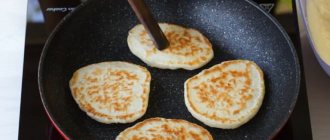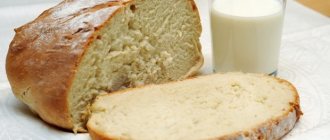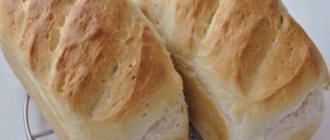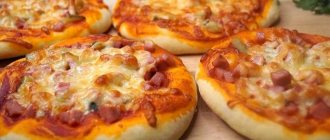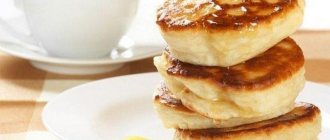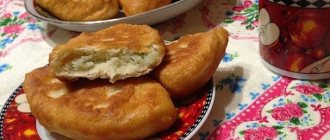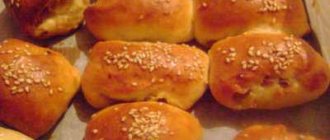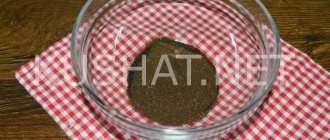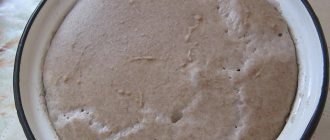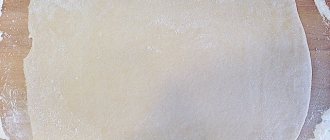origin of name
According to the Torah, the ancient Jews were required to offer a portion of their bread as a sacrifice to God every time they baked bread:
“When you eat the bread of the land, offer an offering to God. Of the firstfruits of your dough you shall offer a cake as an offering; like an offering from the threshing floor, so offer it.”1
After the Second Holy Temple in Jerusalem was destroyed in 70 AD, the Jews could no longer sacrifice bread through the Kohanim; Instead, they began to make a symbolic sacrifice by burning a small portion of the dough, called challah, from the bread prepared for baking.
According to most opinions, the process of separating challah requires a blessing if at least 1 2/3 kilograms of flour are used. If its quantity is from 1.230 to 1.666 kg, the challah is separated without blessing. Well, if there is even less flour, then challah is not separated from the dough.
The challah we eat on Shabbat and holidays is named after the challah that Jews separated from their baked goods thousands of years ago. In this way, this commandment is preserved and takes root in our consciousness.
After kneading the dough (before baking it), we say:
Blessed are You, Lord our God, King of the universe, who sanctified us with His commandments and commanded us to separate the challah (some add: from the dough).
Then we separate a small piece of dough (the size of an egg, about 30 g) and, defiantly holding it in our hand, we say: Kharei zu challah - “This is challah.” Then we hold it over the fire until it becomes inedible (or dispose of it in some other way, showing respect for this piece of dough sanctified by the commandment).
Some people do this in their oven (but not while baking anything else in it). For example, I burn the separated dough on the stove while I braid the challah.
So, originally challah was a separated part of bread. In ancient times, beautiful bread was baked from this dough and given as a gift to the kohanim who served in the Jerusalem Temple.
United by bread
Challah is a traditional bread made from yeast dough, which is prepared in Jewish homes for Shabbat and holidays. But not many people know where this word comes from and what it means. Surprisingly, for the first time it appears in the biblical text and in translation means not so much bread as action with it.
“When you come to the land where I am leading you and eat the bread of the land, you shall set aside an offering to the Lord,” says the Holy Scripture.
This separation must be done with dough prepared using any of the five grains: wheat, barley, rye, oats and spelt. Thus, the “separation of challah” became the traditional process of offering to the Temple. During the existence of both the First and Second Temples of Jerusalem, the separated parts were used for the needs of the priesthood. In the Sanctuary of the Temple, directly opposite the golden menorah, there was a table covered with gold sheets, on which were 12 loaves of bread, which became known as challahs. These delicious breads were replaced before each Shabbat with new ones and symbolized the 12 tribes of Israel.
Although Jews today do not have a Temple, the commandment of separating challah is still observed in traditional families today. It is customary to separate a piece of dough the size of a small chicken egg from the dough for baking challah and burn it on a burner or in the oven.
According to tradition, in homes, two challahs are usually placed on the holiday and Shabbat tables. They symbolize the double portion of mana that fell on the eve of Shabbat in the desert, through which the Jews wandered for 40 years after the exodus from Egypt. Since collecting mana was a work prohibited on Saturday, a double portion of it on Friday solved this problem. This aspect is symbolized by the two challahs on the Shabbat table.
It is noteworthy that now most people associate challah with braided bread, to which raisins or other dried fruits can be added if desired. However, this appearance of the challah is not very old in terms of Jewish history. For the first time, such wicker challahs began to be baked at the beginning of the 15th century in Jewish communities in southern Germany and Austria. In those days, most Jews ate rye bread during the week, and for Shabbat they baked challah from premium white flour.
Over time, eggs and raisins began to be added to challah dough to make them even tastier, and thanks to weaving, challah acquired a truly festive look. It is possible that it was at that time that Europeans adopted from the Jews the tradition of baking white sweet bread, which is known as “berchisbrod” or “perchisbrod”. That being said, there are many recipes for challah. For example, in Sephardic communities it is customary to bake simple challah “on water” - without adding eggs, sugar or other sweeteners.
For various holidays, it is customary in many Jewish communities to bake challahs of various shapes and decorate them in a special way. For example, during the autumn holidays - Rosh Hashanah, Sukkot, Shemini Atzeret and Simchat Torah - it is customary to bake round-shaped challah. This shape symbolizes the cyclical nature of the Jewish year, in each of which the same holidays are repeated. And also round challahs, with their shape resembling a crown, seem to hint at the greatness of the Creator.
On the Saturday before Yom Kippur, the holiest day of the year, it is customary in some communities to decorate challahs with symbolic dough ladders. This symbolizes Moses' ascent to Mount Sinai and the hope that our prayers will reach Heaven on the Day of Judgment. In some communities, it is customary these days to bake special challah - “feigelah” - in the shape of a “bird”. This is an echo of the famous promise of the prophet Yeshayahu: “As birds flutter over their chicks, so the Lord of Hosts will protect and deliver, spare and save.”
And in many communities, on the first Saturday after Passover, challahs in the shape of a key are baked, and in some cases, real keys are baked in such challahs. This tradition is designed to remind us that only the Almighty has the key with which he can open and open the treasury of well-being for us. But no matter how happy and well-fed we are now, we must not forget about the sorrows and persecutions that befell the Jewish people during the Egyptian slavery and other disasters.
That is why, according to most people, it is customary to dip challah in salt. However, according to canonical tradition, this salt should be reminiscent of the salt that the high priests used during the offerings in the Temple. Salt also symbolizes the Jewish people - it never spoils and always helps to reveal the taste of any dish. Other basic ingredients of traditional challah also have their significance - they are associated with spiritual realms. For example, water is a symbol of the Torah, yeast is our ability to grow and expand boundaries, eggs are a symbol of the beginning of a new life, and flour is a symbol of prosperity and hope for the best.
And although now we do not have the opportunity to experience the holiness of the Temple, we can always recreate the holiness of the atmosphere reigning in it. The home of every Jew can become a miniature Temple - a “small Temple”. And the golden table with 12 loaves will replace the festive table with two challahs.
Material prepared by Sheindl Krol
Two loaves
While the ancient Jews were traveling through the desert after the exodus from Egypt, God commanded them to build a portable temple, the Mishkan, and gave detailed instructions on how the decorations and objects that were to be placed inside the Mishkan should look like.
One of the key items was the shulchan - a beautiful table made of wood covered with gold, on which twelve loaves of bread were always displayed.
Later, when the Jews built a permanent Temple in Jerusalem, there were still 12 fluffy loaves (known as showbread) on this table.
And when the Temple was destroyed, each Jewish home became a Mikdash Me'at - a separate miniature temple in which Jews strive to recreate at least some of the holiness that once filled the Temple. And the beautiful challahs on our dining tables remind us of the splendor of the Holy Temple.
It is customary to say the blessing hamotzi on two loaves of bread on Shabbat and holidays. (On Passover, instead of bread, we say this blessing over matzo.)
When our ancestors wandered through the desert for forty years, the Almighty gave them a portion of wonderful food every day, which was called man. On Fridays He gave a double portion of mana so that there would be enough for Shabbat.
Today, thousands of years later, we continue to remember this miracle by blessing the two loaves of challah at our Shabbat and holiday meals.
Lechem Mishneh - double portion of chalot for Shabbat
Hala is a commandment from the Torah and from the sages [↑]
The commandment of separating challah is an imperative commandment from the Torah. However, in the Written Torah it is given only in relation to the Land of Israel and only on the condition that all Jews are there. The sages decided to fulfill this commandment always and in any place so that it is not forgotten.
The Torah also does not indicate the minimum size of dough to be separated (according to Rashi’s explanation, this is indicated by the words “as you offer from the threshing floor, so offer it up” - the quantity was also not indicated regarding this type of trumah). However, our sages set the amount at 1/24 (approx. 4%
) for a private person and
1/48 (approx. 2%
) for a professional baker (
see Rashi on Bamidbar, 16:20
).
The sages also indicated from what minimum amount of flour the dough must be prepared so that challah can be separated from it, and when the commandment of separating challah can be fulfilled with a blessing, and when it is done without it (see below for more information).
).
There is a difference in fulfilling the commandment of separating challah in the Land of Israel and outside it. If outside the Land of Israel you baked something before Shabbat or a holiday and forgot to separate the challah, then you can eat what you baked. You only need to leave a small piece from which you need to separate the challah on a weekday (it cannot be separated on Saturday and holidays).
In the Land of Israel, on the contrary, it is forbidden to eat such baked goods. You must wait until the end of Saturday (holiday), separate the challah, and only then will you be allowed to eat baked goods.
Fabric covering
Before pronouncing the holiday blessing, it is customary to cover the bread with a cloth - this also reminds us of the mana that our ancestors ate in the desert. Every morning the man was covered with a layer of dew.
The challah covering also contains a practical lesson, reminding us of the importance of being sensitive to the feelings of others.
Since it is customary to make a Kiddush on the wine before blessing the bread, some say that covering the challah “spares her feelings,” preventing the Kiddush from being seen as a slight against her.
And if we go to so much trouble to symbolically protect inanimate objects from being “embarrassed,” how considerate should we be to the feelings of people who are actually capable of feeling pain from neglect.
Temple Reminders
After Kiddush we wash our hands and then recite the blessing on the bread:
“Blessed are You, Lord our God, King of the Universe, Who brought forth bread from the ground.”
Ashkenazim have the custom of cutting challah with a knife, like any other bread. But some Sephardim have a tradition of breaking bread, which reminds us that the Jerusalem Temple was built without any sharp objects.
From the very beginning, the purpose of the construction of the holy Temple was exclusively peaceful, therefore no tools that could be used for war or harm to others were allowed to be used on the site of its construction. Stones and other objects were carved in a separate place.
Another custom associated with challah also reminds us of Temple times. After the challah is divided into pieces after the blessing, we sprinkle it with salt before distributing and eating it, just like the ancient offerings in the Temple before dedicating them to God.
Culinary recipes and photo recipes
Recipe for making Jewish bread:
First, knead the dough. The most convenient way to do this is in a bread maker. To do this, pour all the ingredients for the dough into the bread machine bucket in the right order. This recipe used a MoulinexOW 5003 bread maker. First, pour in all the liquid ingredients: warm potato broth, eggs and vegetable oil.
Next, add all the dry ingredients: sugar, salt and sifted flour.
Place pieces of fresh yeast on top of the flour. You can also use dry active yeast, you will need 3 g of it.
Grind fresh yeast with flour into crumbs (just pour dry yeast, no need to grind). Turn on the bread maker on the “Dough” mode and knead the dough. While the bread machine is running, if necessary, add a little flour or potato broth so that the dough is not sticky and holds its shape well.
This challah dough can also be kneaded by hand. To do this, pour warm potato broth into a bowl, dilute sugar and yeast in it. Add eggs and vegetable oil. Sift the flour with salt and add to the yeast mixture. Knead the dough. When the dough comes together into a loose lump, knead it until smooth, about 7-8 minutes. The dough should become pleasant to the touch and elastic.
Remove the finished dough from the bread maker bucket and roll it into a neat ball.
Grease a large bowl with a thin layer of oil and place the dough in it. Cover the bowl with a towel or film and leave in a warm place to rise for 1-2 hours. The dough should increase in volume several times.
Punch down the finished dough and divide into 3 equal parts. Roll each part into a ball. Cover the balls with film and leave for 5-10 minutes so that the dough “relaxes” a little.
Roll the “rested” dough into 3 long ropes.
Make the ends of each strand thinner on both sides than the middle. On one side, carefully connect the ends of the bundles, as shown in the photo.
Weave a loose braid. Fasten the ends of the strands on the other side and hide them underneath. Transfer the future bread to a baking tray lined with baking paper, cover with a towel and leave in a warm place to rise for 40 minutes or more. Challah needs to grow a lot.
When the bread has risen, gently brush it with the beaten egg. Sprinkle sesame seeds, poppy seeds, etc. on top if desired.
Bake Jewish challah at 190-200 C for about 30-40 minutes until golden brown.
Transfer the finished bun to a wire rack and leave to cool completely.
Now you can slice and enjoy – the Jewish bread is ready!
Braided bread made from egg dough
In connection with Shabbat, many people draw lush golden loaves of bread made from butter dough prepared with the addition of eggs. However, many Jews use different types of bread for holiday and Shabbat meals. Many Sephardim eat pita bread. Yemenite Jews use a fluffy bread called salufeh. Indian Jews say ha-motzi on bread called naan or chapati.
It is not necessary to braid Shabbat and holiday bread, although for many Jews it would be no Shabbat without two golden braided loaves on the table.
Food historian Gil Marks notes that the braided egg dough bread we call challah today originated in southern Germany in the early 15th century, when local Jews began using it for their own purposes, calling it herchisbrod or perhisbrod.
Locals baked this braided bread for special occasions. “Thus, braided Lenten bread, reminiscent of a special occasion, soon became the most popular form of Ashkenazi Shabbat bread,” notes Marks in his book, The Encyclopedia of Jewish Food.
In general, there were many types of braided bread, and they were called differently, including berkhes - perhaps from the Hebrew word bracha - “blessing”.
